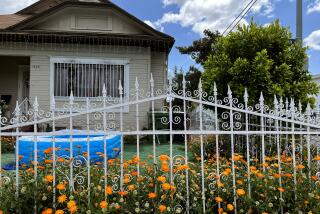Communities Say Keep Out--by Bluffing
The message delivered by the 18-foot-high stone columns and thick iron gates at the entrance to Simi Valley’s Long Canyon development is clear: Keep moving if you have no business here. Same with the guard shack at Sea Pine Gate in Newport Beach.
Don’t be deceived. The security measures are fake.
The road into Long Canyon’s faux Italian villas and French country mansions is never blocked, because the gates are always swung wide open. And Sea Pine Gate actually has no guard--or gate.
Functional gates--those that close or lock--come with problems. They change the status of the thoroughfares within from public to private, for which upkeep costs can add tens of thousands of dollars to home prices. Many city officials oppose them. And especially after Sept. 11, hiring qualified guards to staff them has become a headache.
Yet “certain personality types still need to have some kind of gate because of the affluence it implies,” said Sandra Kulli, president of Kulli Marketing in Malibu. “It’s an ‘I’ve arrived’ attitude.”
Fake gated communities are popping up across California. “There is a trend toward faux gates,” Kulli said. “In a lot of cases people are finding they like them better than real gates.”
It’s a suburban variation on the entries to Bel-Air, which have imposing archways and gatehouses. There are guards to intimidate nosy outsiders, though the guards have no authority to stop even the least stylish interloper from driving into the ritzy neighborhood.
The point of the fakes is to give home buyers the sense of privacy, security and exclusivity that gates provide, without forcing developers to deal with the hassles that come with walling off a community entirely.
Many who want to live in a modern-day fortress find the faux model just as good as the real thing. Real gates are there to make homeowners feel special, exclusive and secure. Fakes have the same effect.
“In the U.S. we are great at buying things we don’t need,” said William Fulton, an expert in urban development. “A lot of this stuff has to do with simply giving home buyers the illusion that they are safer. But that is all it is, an illusion.”
City officials reluctantly accept the fakes, seeing them as at least an improvement over the real thing, which creates a planning nightmare by turning cities into fortified enclaves. They blame locked gates for blocking emergency vehicles and thwarting creation of bike trail networks, among other things.
Add to that several recent studies debunking the theory that gates make large suburban planned communities safer, and you have even the most discriminating home buyers questioning whether being in a closed-off, private development is worth the high cost.
Residents of Harbor View in Newport Beach recently remodeled the unmanned white guard shacks that stand at several entryways to the community. The shacks imply a private community, but anybody is free to come and go.
“They provide a sense of identity,” said Richard Gollis, a real estate consultant who lives there.
Planners in the Bay Area city of San Ramon even have a term for the faux fortresses: “neighborhood entry identities.” The term was coined after the city refused to allow a developer to gate a community.
The solution was to create what appears to be a private street but is not. “It was actually designed to look like a gated community,” said Herb Moniz, who was city manager at the time. “Then it was deemed a more prestigious neighborhood.”
Moniz--himself the reluctant resident of a true gated community, explaining that “it was the only house I could find that I liked”--said city officials decided they could accept a community that pretended to block itself off as long as it followed the rules for public roads and other facilities.
Some critics of true gated communities are of the same mind. They can live with the fakes.
“The fakes seem to have many of the same psychological effects as gates,” said Ed Blakely, who co-wrote “Fortress America: Gated Communities in the United States,” a book considered required reading for the anti-gate set. “They put people on notice that the area is protected.”
He points out that the fake-gate movement isn’t all that new--it’s just gone more upscale. Residents in less well-to-do places began putting up phony gates and gatehouses about the same time the real thing took off with buyers in the 1980s.
“They started as a product of economics for people who couldn’t afford real gates,” Blakely said.
By the mid-1990s, more than 8 million Americans were living behind locked gates. It was about that time that studies by Blakely and others started showing that real gates don’t make most neighborhoods any safer, and in some cases do the opposite.
“The guards turned out not to be the best guardians of people’s possessions,” Blakely said. “In some cases, they were the most likely to take off with them. You were employing people who make very little money, know when residents are not at home and are under light supervision. Some found they could supplement their income by taking things out of the houses they were supposed to protect.”
Fulton, the urban development expert, does think it’s a shrewd move by developers to use the fakes, thus leaving open the possibility of closing out the rest of the world should the real thing come back into style. All it would take is putting in a lock and intercom, or installing a guard in that empty booth.
“You could say the developers are just creating a future option,” he said.



